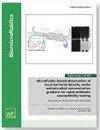Soluto-thermal Marangoni convection in stationary micro-bioreactors on heated substrates: Tool for in vitro diagnosis of PSA
IF 2.4
4区 工程技术
Q2 BIOCHEMICAL RESEARCH METHODS
引用次数: 0
Abstract
The investigation of antigen-laden droplet deposition patterns on antibody-immobilized substrates has potential for disease detection. Stationary droplets that contain antigens on surfaces immobilized with antibodies can function as microreactors. Temperature modulation enhances reaction efficiency and reduces detection time in droplet-based systems. Thus, the aim of this study is to explore the impact of substrate heating on the structures of protein deposits and the influence of substrate temperature on thermo-solutal Marangoni convection within the droplets. Previous research has explored deposition patterns as diagnostic tools, but limited investigations have focused on the effects of substrate heating on protein deposit structures and the influence of substrate temperature on thermo-solutal Marangoni convection within droplets, creating a knowledge gap. In this study, we conducted experiments to explore how heating the substrate affects the deposition patterns of droplets containing prostate-specific antigen (PSA) on a substrate immobilized with anti-PSA IgG. Additionally, we investigated the thermo-solutal Marangoni convection within these droplets. Our findings reveal distinct deposition patterns classified into dendritic structures (heterogeneous), transitional patterns, and needle-like (homogeneous) structures. The presence of prominent coffee rings and the variation in crystal size across different groups highlight the interplay between thermal and solutal Marangoni advection. Entropy analysis provides insights into structural differences within and between patterns. This work optimizes substrate temperatures for reduced evaporation and detection times while preserving protein integrity, advancing diagnostic tool development, and improving understanding of droplet-based systems.加热基底上固定微型生物反应器中的溶解-热马兰戈尼对流:PSA 体外诊断工具
研究抗体固定化基底上的抗原液滴沉积模式具有疾病检测的潜力。在固定有抗体的表面上含有抗原的静止液滴可作为微反应器使用。温度调节可提高基于液滴系统的反应效率并缩短检测时间。因此,本研究旨在探索基底加热对蛋白质沉积结构的影响,以及基底温度对液滴内热溶马兰戈尼对流的影响。以往的研究已将沉积模式作为诊断工具进行了探索,但关于基底加热对蛋白质沉积结构的影响以及基底温度对液滴内热溶性马兰戈尼对流的影响的研究还很有限,这造成了知识空白。在本研究中,我们通过实验探索了基底加热如何影响固定有抗 PSA IgG 的基底上含有前列腺特异性抗原 (PSA) 的液滴的沉积模式。此外,我们还研究了这些液滴内部的热溶解马兰戈尼对流。我们的发现揭示了不同的沉积模式,分为树枝状结构(异质)、过渡模式和针状结构(均质)。突出的咖啡环的存在以及不同组别晶体大小的变化,凸显了热和溶质马兰戈尼对流之间的相互作用。熵分析深入揭示了图案内部和图案之间的结构差异。这项工作优化了基底温度,从而缩短了蒸发和检测时间,同时保持了蛋白质的完整性,推动了诊断工具的开发,并加深了人们对液滴系统的了解。
本文章由计算机程序翻译,如有差异,请以英文原文为准。
求助全文
约1分钟内获得全文
求助全文
来源期刊

Biomicrofluidics
生物-纳米科技
CiteScore
5.80
自引率
3.10%
发文量
68
审稿时长
1.3 months
期刊介绍:
Biomicrofluidics (BMF) is an online-only journal published by AIP Publishing to rapidly disseminate research in fundamental physicochemical mechanisms associated with microfluidic and nanofluidic phenomena. BMF also publishes research in unique microfluidic and nanofluidic techniques for diagnostic, medical, biological, pharmaceutical, environmental, and chemical applications.
BMF offers quick publication, multimedia capability, and worldwide circulation among academic, national, and industrial laboratories. With a primary focus on high-quality original research articles, BMF also organizes special sections that help explain and define specific challenges unique to the interdisciplinary field of biomicrofluidics.
Microfluidic and nanofluidic actuation (electrokinetics, acoustofluidics, optofluidics, capillary)
Liquid Biopsy (microRNA profiling, circulating tumor cell isolation, exosome isolation, circulating tumor DNA quantification)
Cell sorting, manipulation, and transfection (di/electrophoresis, magnetic beads, optical traps, electroporation)
Molecular Separation and Concentration (isotachophoresis, concentration polarization, di/electrophoresis, magnetic beads, nanoparticles)
Cell culture and analysis(single cell assays, stimuli response, stem cell transfection)
Genomic and proteomic analysis (rapid gene sequencing, DNA/protein/carbohydrate arrays)
Biosensors (immuno-assay, nucleic acid fluorescent assay, colorimetric assay, enzyme amplification, plasmonic and Raman nano-reporter, molecular beacon, FRET, aptamer, nanopore, optical fibers)
Biophysical transport and characterization (DNA, single protein, ion channel and membrane dynamics, cell motility and communication mechanisms, electrophysiology, patch clamping). Etc...
 求助内容:
求助内容: 应助结果提醒方式:
应助结果提醒方式:


